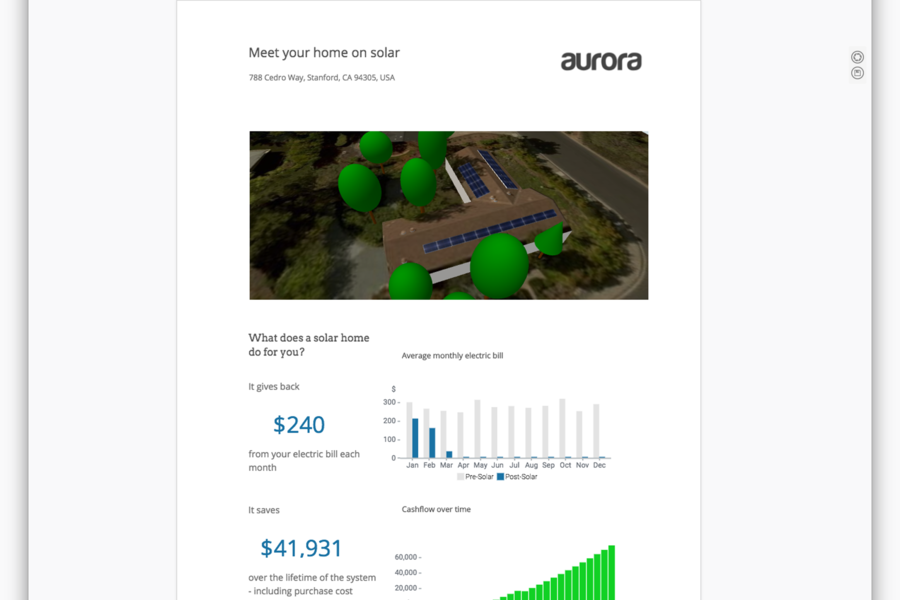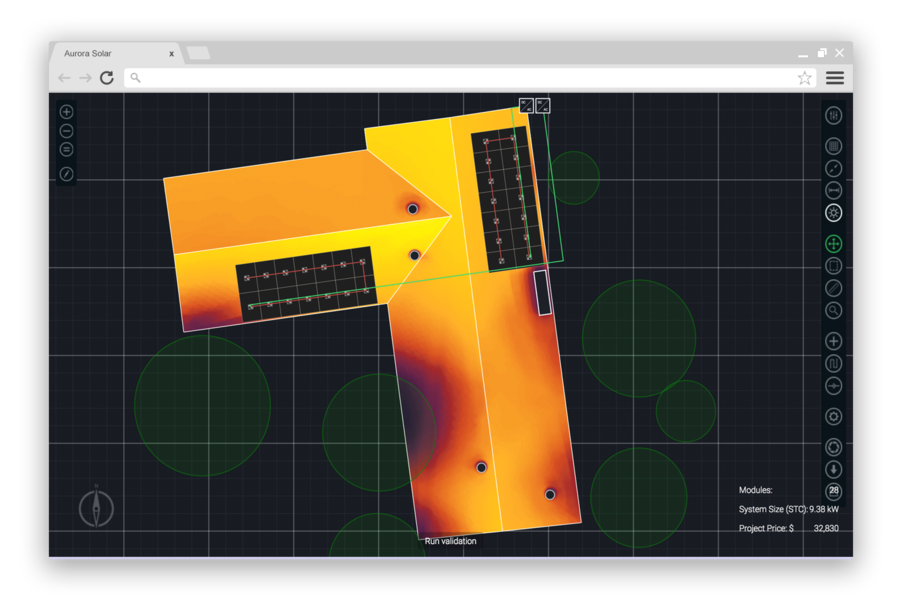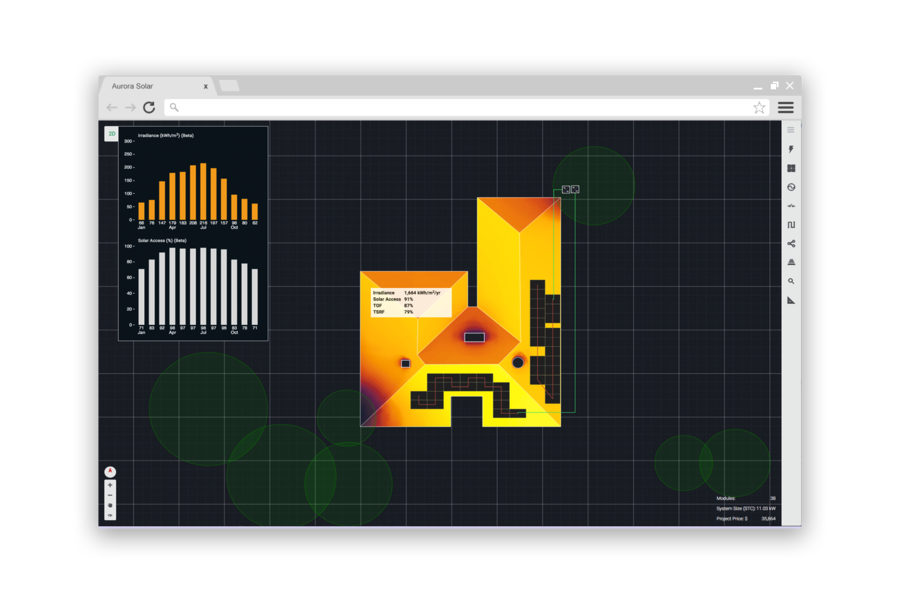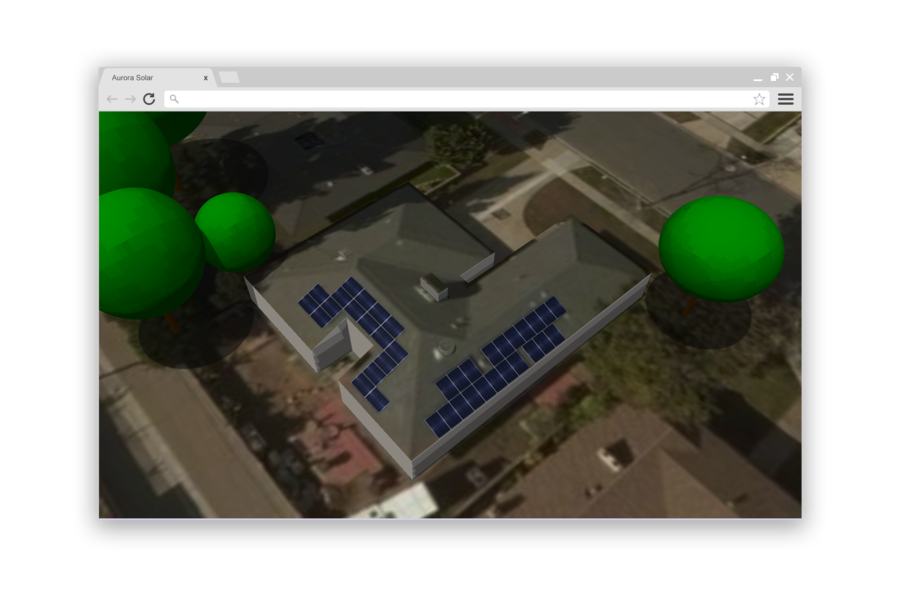Aurora Solar, a cloud-based software solution, is catered towards enhancing solar engineering design and sales proposals. It provides users with workflow management, sales facilitation and customer acquisition functionality.
A highlight of the Aurora Solar platform is its ease of use. Users can save time through remote site analysis, design accurate commercial projects, increase sales with winning proposals and provide precise energy production estimates for their customers.
All that’s required to start the solar sales and design process is an address and electric bill, then the systems advanced modeling and analytics will take it forward. With this data, you can now easily create complete engineering designs and sales proposals. If done manually, this entire process can take much longer. However, with Aurora Solar, efficiency and organization are easily facilitated.
Aurora Solar Features
Aurora Solar offers a range of advanced features. Core functionalities include:
Pre-qualification tools
Adequate pre-qualification tools are necessary for creating tailored solar designs for clients and projects. Aurora Solar provides several including streamlined roof drawing, LIDAR-assisted modeling, sun path diagrams, tree and obstruction shadow simulation and the ability to display fire-code setbacks. Overall, these features help create the most accurate model representations.
For example, with easy roof drawing, you can trace accurate roof outlines over a satellite image with a few simple clicks. This helps you estimate the sizes of the solar panes and classify complex roof structures. It also lets you calculate azimuths and apply fire-code setbacks. In creating 3D models, tools such as LIDAR-assisted modeling lets users utilize CAD-based satellite imagery. With sun path diagrams, you can predict the animation of the sun’s movement during any time, day or month. This helps you create models with real-life obstructions and similar factors in mind.
Additional pre-qualification features include the ability to model your customer’s electricity load profile and conduct shading analysis. The solution enables you to accurately estimate a customer’s electric consumption based on their bill and location, as well as adjust it by configuring lighting, pool type, and other factors.
System design
System designing can be made easier with drag-and-drop modules and BOS components. Aurora Solar facilitates interactive design, operational convenience, automatic system design, as well as provides an extensive component library and single-line diagrams. With these tools, you can receive real-time feedback when it comes to component placement and electrical configurations.
The solution can also be convenient in that you can automatically fill roof surfaces with pre-strung modules, inverters and BOS components—all done through simply clicking and dragging. Another strong tool in its arsenal includes automatic system design. If you’re looking to generate the most cost-effective system and maximize bill savings, then you can rely on Aurora’s bleeding-edge algorithm to run through thousands of combinations to instantly reach optimized designs.
Performance simulation
Aurora Solar also offers precise energy performance simulation. With this feature, you can have the cell string-level simulation engine giving you highly accurate predictions. Another benefit of this solution is the sub-module analysis in simulations.
The solution can also be useful for generating loss attribution reports. With detailed performance loss-tree diagrams, you can see precise details on how much your system has lost from shading, suboptimal tilt and orientation or inverter clipping.

Aurora Solar Benefits
Primarily, users can gain the following benefits when using Aurora Solar:
Save time
A core benefit of Aurora Solar is that through its wide range of features it can help reduce the time and energy otherwise spent switching between different applications. Instead of relying on multiple solutions, you can have an all-in-one solar design and sales solution in Aurora Solar.
Furthermore, Aurora Solar’s commercial suite also has design and financial analysis tools custom-built for C&I projects. Additional features include depreciation tax shield calculation and standardized PV systems.
With access to streamlined system design and performance simulation, you shouldn’t have to be concerned about the time it takes in creating tailored solar designs for your customers.
Increase sales
Solar designs are generally obsolete without the ability to provide customers with in-depth proposals. As such, Aurora Solar can make traditional spreadsheets and presentations look messy in comparison to what they offer. The solution makes use of all the information found from your solar designs and simulations to easily and automatically calculate financial returns for loans, leases and cash payments. All of this is managed with the click of a button.
Centralized location
At the end of the day, the main reason why Aurora Solar can work so easily is due to its cloud-based deployment. Users can easily collaborate and share information online and from any computer. It also makes it easier to gather real-time data. Everything you need can be found in one place and accessed anywhere, without having to physically visit a site.

Aurora Solar Pricing
Aurora Solar has two pricing models—monthly and annual. You can save more with the annual pricing model. For the Basic plan, you can save up to $288 per year and for the Premium, you can save up to $468 per year. If you’re certain of Aurora Solar’s services, then it’s best to subscribe to the annual plan. However, if you’re testing out the platform first, then try the monthly versions first. This helps solidify your decision based on Aurora Solar’s features and functionalities. Aurora also assures users that accounts can be canceled any time and they can receive a refund within two weeks.
For its monthly pricing plans, Aurora Solar has three—Basic, Premium and Enterprise. They have different price ranges and available features. The first plan entitled Basic, whose price is pegged at $159 per user and month, is catered specifically for creating residential system designs and sales proposals. Its features include 3D visualizations, annual shade values, financial analysis, sales proposals, automatic system design, split-screen street view integration and paid 3D-modeling service.
The second pricing plan, Premium, is priced at $259 per user and month. It’s perfect for growing teams who do in-depth analysis and engineering. Its notable features include those from Basic with additional ones like LIDAR-assisted modeling, commercial design, automatic obstruction detection, NEC validation and BOS components.
The third pricing plan is called Enterprise. It’s catered specifically for organizations with quotations for thousands of systems per month. It has everything that Basic and Premium offered in their pricing plans. There’s no fixed price for this plan but you can contact customer support to request a quote. Features include API integration, user access permissions, monthly analytics reports, dedicated customer success representative and preferential pricing for add-on services.
Free demos are available for Basic and Premium plans.
Conclusion
If you’re looking to make solar designing and sales pitching easier, then it can be worth considering Aurora Solar. It has a range of features catered towards assisting users in pre-qualification, system design, performance simulation, and sales enhancement.
At its core, Aurora Solar can help to replace the troublesome process of using various tools or having to physically visit sites just to produce and work on a single solar installation project. Overall, the solution’s innovative and scalable features can certainly help to simplify the entire solar design and sales process.









